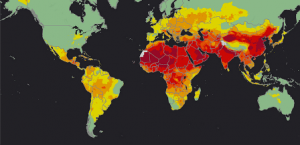Most of world’s population breathes dirty air·
… WHO releases new air quality model
A new WHO air quality model confirms that 92% of the world’s population lives in places where air quality levels exceed WHO limits.
WHO says some 3 million deaths a year are linked to exposure to outdoor air pollution. Indoor air pollution can be just as deadly. In 2012, an estimated 6.5 million deaths (11.6% of all global deaths) were associated with indoor and outdoor air pollution together.
Nearly 90% of air-pollution-related deaths occur in low- and middle-income countries, with nearly 2 out of 3 occurring in WHO’s South-East Asia and Western Pacific regions.
Ninety-four per cent are due to noncommunicable diseases – notably cardiovascular diseases, stroke, chronic obstructive pulmonary disease and lung cancer. Air pollution also increases the risks for acute respiratory infections.
“Air pollution continues take a toll on the health of the most vulnerable populations – women, children and the older adults,” adds Dr Bustreo. “For people to be healthy, they must breathe clean air from their first breath to their last.”
Major sources of air pollution include inefficient modes of transport, household fuel and waste burning, coal-fired power plants, and industrial activities. However, not all air pollution originates from human activity. For example, air quality can also be influenced by dust storms, particularly in regions close to deserts.
“The new WHO model shows countries where the air pollution danger spots are, and provides a baseline for monitoring progress in combatting it,” says Dr Flavia Bustreo, Assistant Director General at WHO.
It also represents the most detailed outdoor (or ambient) air pollution-related health data, by country, ever reported by WHO. The model is based on data derived from satellite measurements, air transport models and ground station monitors for more than 3000 locations, both rural and urban. It was developed by WHO in collaboration with the University of Bath, United Kingdom.
The model has carefully calibrated data from satellite and ground stations to maximize reliability. National air pollution exposures were analysed against population and air pollution levels at a grid resolution of about 10 km x 10 km.
“This new model is a big step forward towards even more confident estimates of the huge global burden of more than 6 million deaths – 1 in 9 of total global deaths – from exposure to indoor and outdoor air pollution,” said Dr Maria Neira, WHO Director, Department of Public Health, Environmental and Social Determinants of Health. “More and more cities are monitoring air pollution now, satellite data is more comprehensive, and we are getting better at refining the related health estimates.”
Interactive maps
The interactive maps provide information on population-weighted exposure to particulate matter of an aerodynamic diameter of less than 2.5 micrometres (PM2.5) for all countries. The map also indicates data on monitoring stations for PM10 and PM2.5 values for about 3000 cities and towns.
“Fast action to tackle air pollution can’t come soon enough,” adds Dr Neira. “Solutions exist with sustainable transport in cities, solid waste management, access to clean household fuels and cook-stoves, as well as renewable energies and industrial emissions reductions.”
About author
You might also like
NMA, AMLSN pledge to end inter-professional rivalries
“No delay, end disputes for the good of your patients now,” Kaduna deputy governor urges There seems to be end in sight to disharmony between the Nigeria Medical Association (NMA)
Obesity rising in Africa
Obesity is rising rapidly in Africa. Between 2000 and 2016, Africa nearly doubled the number of overweight adults. The trends are same for children. Africa is currently home to 28%
Lagos Restates Commitment to Reduction of Non Communicable Diseases
The Lagos State Government has once again restated its commitment towards the reduction of the burden of non-communicable diseases (NCDs) like hypertension, diabetes and cancers of the breast, cervix and









0 Comments
No Comments Yet!
You can be first to comment this post!